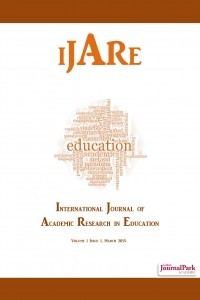The Impact of Literature Circles on the Motivation of Turkish EFL Students towards Literature: An Evaluation of Teachers’ Perceptions
The Impact of Literature Circles on the Motivation of Turkish EFL Students towards Literature: An Evaluation of Teachers’ Perceptions
This study aims to determine why teachers prefer implementing literature circles. It also aims to discover if the literature circle helps students’ comprehension of literature and language and how it affects students’ attitudes towards reading through teachers’ perceptions. Along with the presence, implementation and effect of literature circles in education, processes and changes that students go through while taking part in the circles based on selected literary works were investigated. When the data gathered through interviews with circle teachers were analysed, it supported the view that use of literature circles clearly helps students to understand literature better by increasing their desire to read. Additionally, the view that students’ general attitudes towards reading change positively after taking part in the circles was supported by the results. The results also emphasized that students can develop better comprehension techniques in the circles which will enable them to use the literature for authentic and meaningful purposes.
Keywords:
literature circles, student-centred education, teaching literature, reading activities, student attitudes teacher perceptions,
___
- Avcı, N. (2013). Teachers’ Perceptions of Increased Appreciation and Understanding of Literature through Literature Circles. (Unpublished master’s thesis). Çağ University, Mersin, Turkey.
- Avcı, S.; Baysal, N.; Gül, M.; Yüksel, A. (2011). Impact of literature circles on reading comprehension skill. Sempozyum: 1. Uluslararası Eğitim Programları ve Öğretim Kongresi, Eskişehir.
- Baştuğ, H.; Avcı, S.; Yüksel, A. (2011). Cognitive and affective contributions of the literature circles method on the acquisition of reading habits and comprehension skills in primary level students. 1st International Conference on Foreign Language Teaching and Applied Linguistics, Sarajevo.
- Bedel, O. (2011). Literature Circles in EFL: How they stimulate the social interaction. Retrieved December 6, 2018 from http://eltdigest.com/literaturecircles/
- Daniels, H. (1994). Literature Circles: Voice and Choice in the Student-Centered Classroom. National-Louis University, Stenhouse Publishers York, Maine.
- Daniels, H. (2002). Expository text in literature circles. Voices from the Middle, 9 (4), 7-14.
- Daniels, H. (2006). What’s the next big thing with literature circles? Voices from the Middle, 13(4), 10-15.
- Fraenkel, J. R., Wallen, N. E. (2006). How to Design and Evaluate Research in Education (6th ed.). McGraw Hill.
- Hill, B. C. (2007). Proceedings from Nesa Conference ’07: Literature circles and response. Greece. Retrieved December 20, 2018 from http://bonniecampbellhill.com/Handouts/Handouts/NESALitCircleHandoutAthens07.pdf
- Yayın Aralığı: Yıllık
- Başlangıç: 2015
- Yayıncı: Süleyman Nihat ŞAD
Sayıdaki Diğer Makaleler
Burak AYÇİÇEK, Tuğba YANPAR YELKEN
A Systematic Literature Review: Constructivism in Multidisciplinary Learning Environments
Hülya GÜLAY OGELMAN, Hatice ERTEN SARIKAYA, Hande GÜNGÖR, Özlem KÖRÜKÇÜ
An Interview with Keith E. Wittington: Free Speech, Hate Speech and the University
